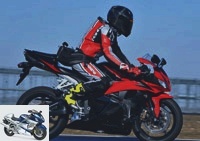With C-ABS, Honda CBRs put the brakes on the competition !

Resolutely focused on safety, Honda ignores prejudices by equipping its CBR 600 and 1000 sports cars with sophisticated electronic ABS (C-ABS). A daring bet in a category where performance takes precedence but which seems poised to be won… Test !
Technique: the secret of the worm…
After reflection, the Japanese firm therefore adopted a more sophisticated system, making generous use of electronics so that braking management is as fast and as transparent as possible for the pilot: two sine qua non conditions for Honda sports cars do not get taxed every time you brake! In fact, the 2009 CBR C-ABS keep their four-piston radial calipers, in different colors on the ABS version (read). The device only intervenes when the speed of the motorcycle exceeds 6 km / h and the pressure exerted on the lever or the pedal exceeds 0.5 bar..
At this moment, an ECU (Electronic Control Unit) analyzes the speed of the machine thanks to sensors and toothed rings mounted on each wheel: if too high a difference is detected, the electronics "bypass" the brake controls. operable by the pilot.
It is then really the computer which decides the braking pressures (up to 80 bars!) To send to each caliper, depending of course on the pilot’s requests! However, and this is the specificity of the system, this transition would be completely invisible by it, insofar as a valve unit is responsible for returning a feeling of "normal" firmness to the controls, via a simulation piston. !
Clearly, Honda has created an artifice allowing the pilot to believe that he is constantly controlling his braking … while the computer and its complicated network of solenoid valves have long since taken control! Subtle, the maneuver also shows that the first manufacturer did not underestimate the ego of its customers most focused on sport. !
While the pilot thinks he is managing his braking, the ECU activates a modulator producing the requested hydraulic pressure through a sophisticated electric motor. This consists of a crankshaft which actuates not a piston (unlike "traditional" ABS), but a worm…
This screw would be precisely the key (along with the electronics) to the smooth operation of the C-ABS because unlike a simple piston, it would send a regular flow, avoiding the traditional peaks in hydraulic pressure felt at the controls when triggering the ABS and also that unpleasant feeling that the motorcycle "brakes, does not brake, brakes, does not brake"…
In a good handset, the system does not forget to balance the pressures between the front and the rear: thus, the bike would keep a skilfully calculated attitude, whether the rider grips only the front brake or the rear brake. ! However, it is still possible to "lick" the rear brake without the ECU trying to send pressure to the front: a very useful asset for correcting your trajectory on the road, but also (especially?) On the track !
Alexandre BARDIN – Photos Stan PEREC and David REYGONDEAU
Related articles
-
With C-ABS, Honda CBRs put the brakes on the competition ! Resolutely focused on safety, Honda ignores prejudices by equipping its CBR 600 and 1000…
-
With C-ABS, Honda CBRs put the brakes on the competition ! Resolutely focused on safety, Honda ignores prejudices by equipping its CBR 600 and 1000…
-
With C-ABS, Honda CBRs put the brakes on the competition ! Resolutely focused on safety, Honda ignores prejudices by equipping its CBR 600 and 1000…
-
With C-ABS, Honda CBRs put the brakes on the competition ! Resolutely focused on safety, Honda ignores prejudices by equipping its CBR 600 and 1000…
-
With C-ABS, Honda CBRs put the brakes on the competition ! Resolutely focused on safety, Honda ignores prejudices by equipping its sports CBR 600 and…
-
With C-ABS, Honda CBRs put the brakes on the competition ! Resolutely focused on safety, Honda ignores prejudices by equipping its CBR 600 and 1000…
-
Sportive – Honda CBR600RR 2013 test: sacred fire – Honda CBR600RR 2013 technical update
2013 Honda CBR600RR Review: Sacred Fire Will the 2013 Honda CBR600RR be able to replace its rivals with a slight facelift, fine-tuned injection and a new…
-
R&D – Honda offers the first electronic ABS – CBS for sports cars! – Used HONDA
Honda offers the first electronic ABS – CBS for sports cars ! Pursuing its quest for greater safety on motorcycles, Honda dares to take an important step…
-
2012 Honda Crosstourer test: V4 and DCT as key assets The maxi trail motorcycle segment is doing well in France but it is monopolized by one and the same…
-
All Tests – Test CTX1300: Honda’s new cruiser – Honda CTX 1300 technical update
CTX1300 test: Honda’s new cruiser The Honda regiment is completed this year by a new recruit: the CTX1300. Halfway between a custom and a road, this “…